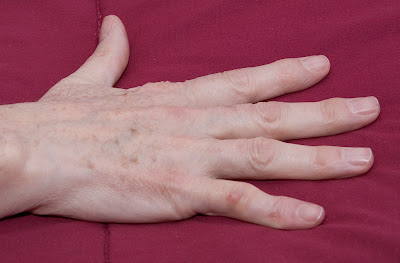On Dec. 18th, 2007, I had surgery to repair this. It was done by a leading plastic surgeon, Dr Paul Binhammer, here at Sunnybrook Health Sciences Centre in Toronto. He did the procedure right in his office. The procedure, called Needle Aponeurotomy, or NA for short, did not take long, probably about 15 to 20 minutes. The worst, or most painful part of the whole procedure was the local freezing, in which he had to inject a needle in my finger in several places. Once it was frozen, the actual surgery was completely painless.
He made very small needle point incisions, and with a small needle-like scalpel, he cut the cords just under the skin which were causing the finger to contract. The finger almost immediately straightened out. After a light bandaging, he sent me over to have a custom split made. The cost of this was around $25 – this was the only cost incurred for the entire procedure, since the actual surgery was covered by our provincial medical insurance, OHIP. I am supposed to only wear the split at night when sleeping, and leave it off during normal daily activities.
The next day, I removed the bandages, and there were only a few small scab spots where he had done the surgery. There was virtually no pain, and the use of my finger was pretty much back to normal; there was no discomfort, and it did not hamper any activities in any way.
Dr. Binhammer asked me if I would like to participate in a controlled study, to "Study the Effects of Steroid Injection With Percutaneous Needle Aponeurotomy in Patients with Dupuytren's Contracture". The complete text ( 5 pages ) of this study can be found here. Approximately 44 people are in the test, where triamcinolone acetonide is injected into the finger after the surgery. Follow up visits are scheduled to track progress, and to get further injections. I have already been back once, around mid-January for a second injection. And, like the needle for the anesthetic, these steroid needles also hurt. My next appointment is in March.
Today, my finger is almost completely straight – with maybe a 5-degree bend. There is still slight pain on the inside of the joint where he stuck the needles in. It is only painful to touch, or when pressure is put on it. It feels like nerve damage. Hopefully, this will fade with time. And the top of my knuckle seems to have a bit of a callus lump, which is a bit red and sore. I am quite sure this is caused by the splint, and for the past few days, I have been sleeping without it to allow it to heal a bit.
The following photo is of my hand a few days after the surgery:

The next two photos are what my hand looks like today:


The next two photos show the splint that was made for me to wear each night; it is made of a hard plastic that thay moulded to fit my hand, and is held in place with velro straps (I added some felt pads inside for comfort):


And finally, a couple of photos of my hand in the splint. Basically, it holds my ring and small finger straight; I also use a small glove to make it a bit more comfortable:


No comments:
Post a Comment